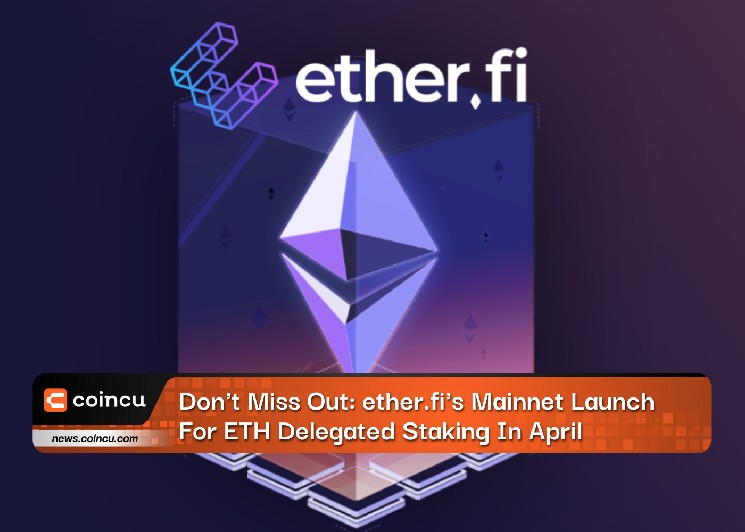Don’t Miss Out: ether.fi’s Mainnet Launch For ETH Delegated Staking In April

The launch of ether.fi will occur in three phases. Phase 1 will take place in April and will involve the protocol going live on the mainnet with ETH delegated staking following Shanghai. Phase 2, which is scheduled for Q2 23 or Q3 23, will see the eETH liquidity pool go live. Finally, Phase 3 is scheduled for Q4 23 or Q1 24, and will involve the launch of the Permissionless Node Marketplace.
https://t.co/gbHcksxzp2 will be launching in (3) phases
PHASE 1: April
Live on mainnet with ETH delegated staking following ShanghaiPHASE 2: Q2 23 or Q3 23
eETH liquidity pool goes livePHASE 3: Q4 23 or Q1 24
Launch of Permissionless Node Marketplace #liquidstaking pic.twitter.com/xHPJLzX3QE— ether.fi (@ether_fi) March 8, 2023
In Phase 1, ether.fi will release a desktop app for delegated staking via an auction mechanism. The staking rewards and unstaked ETH can be withdrawn, and the protocol will offer transferrable NFTs and bond NFTs that confer ownership of the withdrawal safe. The protocol treasury contract will also be launched.
Phase 2 will involve the integration of an oracle for validator node information and launching the ether.fi Liquid Staking Derivative (LSD) token, eETH. An ether.fi liquidity pool will be available for trades of ETH, eETH, and T-NFT. The protocol treasury management contract will also be launched.
Finally, Phase 3 will see the release of the ether.fi node client, the integration of Distributed Validator Technology, and the launch of ether.fi infrastructure services and the ether.fi infrastructure service billing contract.
Stakers with less than 32 ETH, or those who don’t wish to take on the responsibility of monitoring validator nodes, can participate in ether.fi staking by minting eETH in the NFT liquidity pool. The pool contains a mixture of assets consisting of ETH and T-NFTs, and at any given time, ETH represents a small percentage of the pool assets.
Bond holders can deposit their ETH into the pool and enter a queue to be allocated a B-NFT. These stakers perform a similar role to full-node stakers who have sold their T-NFT. When the amount of ETH in the liquidity pool crosses above a threshold, the next bond-holder staker in the queue is assigned.
DISCLAIMER: The Information on this website is provided as general market commentary and does not constitute investment advice. We encourage you to do your own research before investing.







 Bitcoin
Bitcoin  Ethereum
Ethereum  Tether
Tether  Dogecoin
Dogecoin  USDC
USDC  Cardano
Cardano  TRON
TRON  Chainlink
Chainlink  Stellar
Stellar  Hedera
Hedera  Bitcoin Cash
Bitcoin Cash  Litecoin
Litecoin  LEO Token
LEO Token  Cronos
Cronos  Ethereum Classic
Ethereum Classic  Monero
Monero  Algorand
Algorand  Dai
Dai  OKB
OKB  Cosmos Hub
Cosmos Hub  Stacks
Stacks  Theta Network
Theta Network  Gate
Gate  Tezos
Tezos  Maker
Maker  KuCoin
KuCoin  IOTA
IOTA  NEO
NEO  Polygon
Polygon  Zcash
Zcash  Synthetix Network
Synthetix Network  Tether Gold
Tether Gold  Dash
Dash  TrueUSD
TrueUSD  Zilliqa
Zilliqa  Holo
Holo  0x Protocol
0x Protocol  Enjin Coin
Enjin Coin  Basic Attention
Basic Attention  Qtum
Qtum  Siacoin
Siacoin  Ravencoin
Ravencoin  Decred
Decred  DigiByte
DigiByte  Bitcoin Gold
Bitcoin Gold  Hive
Hive  NEM
NEM  Ontology
Ontology  Huobi
Huobi  Nano
Nano  Status
Status  Waves
Waves  Lisk
Lisk  Steem
Steem  Numeraire
Numeraire  Pax Dollar
Pax Dollar  BUSD
BUSD  OMG Network
OMG Network  Ren
Ren  Bitcoin Diamond
Bitcoin Diamond